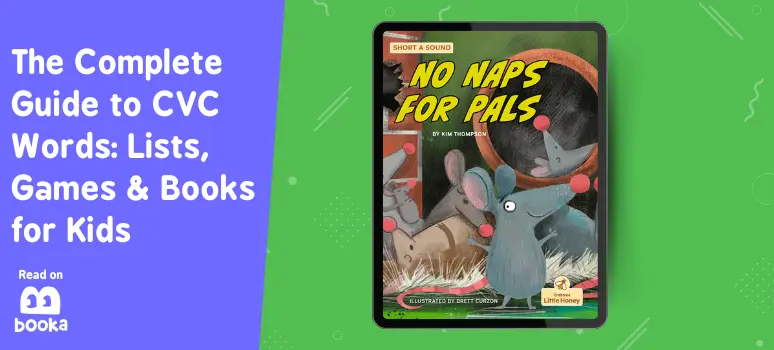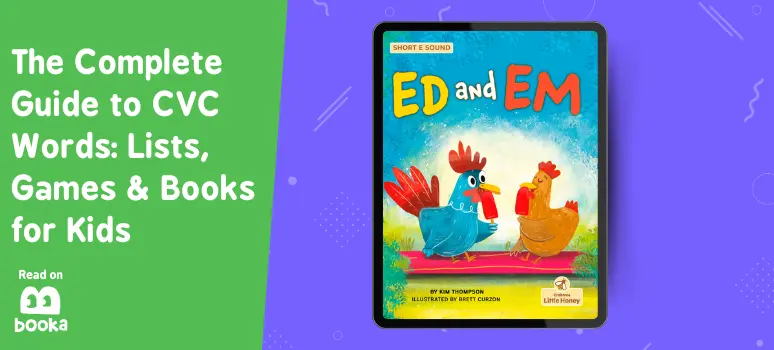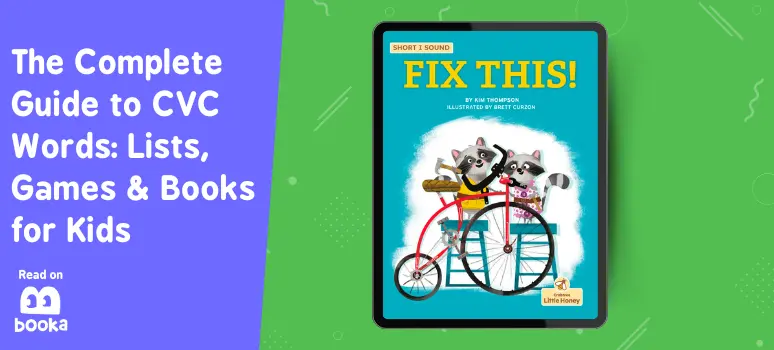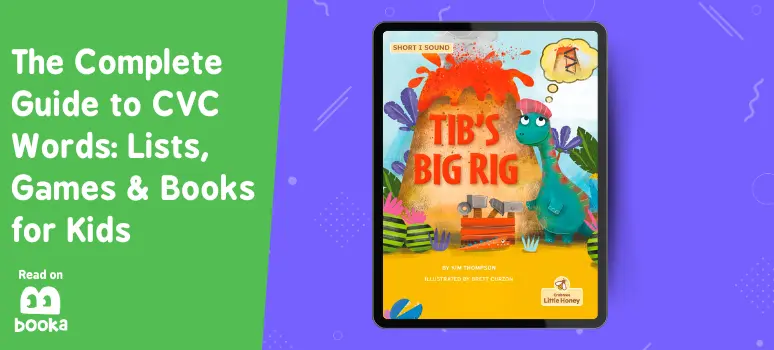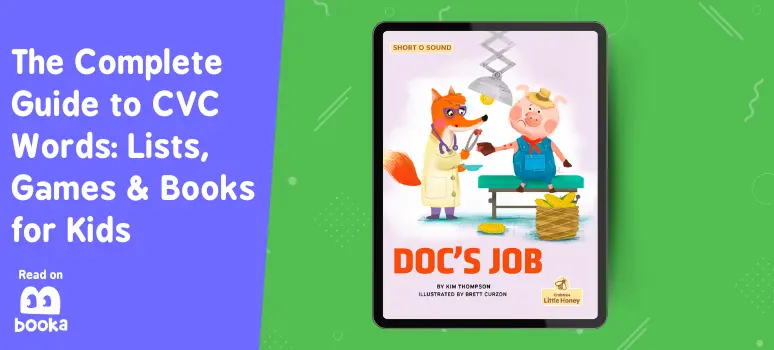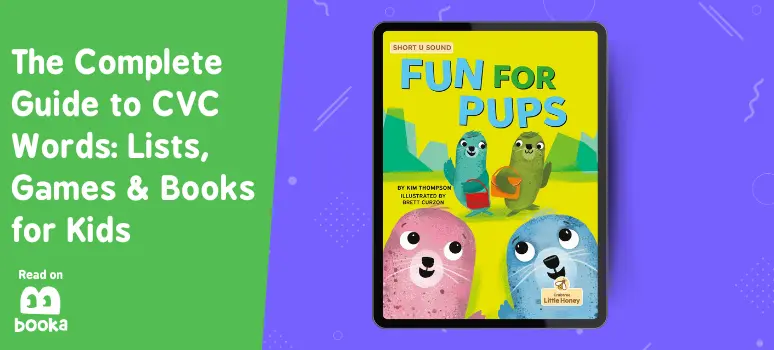CVC words provide the foundation for strong literacy skills, making them essential to early reading development.
In this guide, we’ll explain what CVC words are, provide a comprehensive CVC words list, and explain how to teach these words at home step by step. We’ll also share our favorite CVC word games and books. Finally, we’ll share a pro teaching tool you can use to teach CVC words at home.
Ready to explore our Ultimate Guide to CVC Words for Kids? Let’s go!
What are CVC words?
If you’re teaching your child to read, you’ve likely come across the term CVC words—but what exactly does this mean? Let’s break it down.
What does CVC stand for?
CVC is an acronym. The full form of “CVC words” is Consonant Vowel Consonant Words.
CVC Words Meaning
CVC words are basic, three-letter words that follow a simple pattern:
consonant sound (C) + vowel sound (V) + consonant sound (C)
Since these words are made up of simple, predictable sounds, they’re often the first words children learn to read independently.
In most cases (almost always, in fact), the vowel between the two consonants makes a short vowel sound. But, of course, there are exceptions to this rule. As a result, some teachers use the terms “consonant vowel consonant words” and “short vowel words” interchangeably—and refer to basic short vowel words as “CVC words.”
Examples of CVC Words
Below are some examples of high frequency words that are also consonant vowel consonant words. These terms occur frequently in written text. Therefore, they are essential for your child to know!
- bad
- big
- can
- did
- get
- had
- him
- his
- let
- man
- not
- red
- run
- set
- sun
- top
Looking for more consonant vowel consonant words? Check out our complete list of CVC words for kids below.
Why are consonant vowel consonant words important?
CVC words are important because they help young readers develop phonemic awareness, blending, and decoding skills. How? Well, their simple, predictable structure makes it easy for kids to identify individual sounds, blend them together, and recognize common spelling patterns.
By mastering consonant vowel consonant words, kids gain the confidence to read longer words, improving their overall reading fluency. This early success lays a strong foundation for more advanced literacy skills.
CVC Words List
Finding the right CVC words list can make teaching early reading skills easier for parents and caregivers! So, we’ve put together a carefully selected list that includes some of the most common consonant vowel consonant words.
We've grouped the words on our list into helpful categories to make it easier for you to find the right words for your child's reading level. Below, you’ll find lists for all types of consonant vowel consonant words, including super simple terms, CVC word lists for short vowels a, e, i, o, and u, and lists for different age/reading levels. So, whether you're teaching a preschooler, kindergartener, or early elementary student, these lists will help you determine suitable CVC words.
Super Simple CVC Words with Pictures
Below is a list of simple CVC words with pictures to help your child connect the words with real-world objects. These easy words are perfect for beginners.
- bat
Used in a sentence: The bat flew into the cave.
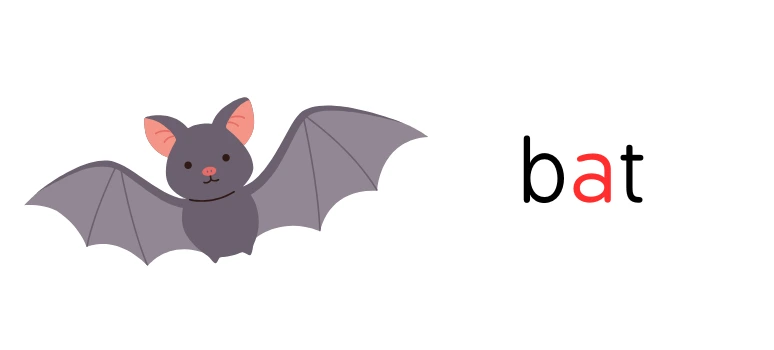
- cat
Used in a sentence: The cat is sleeping on the mat.
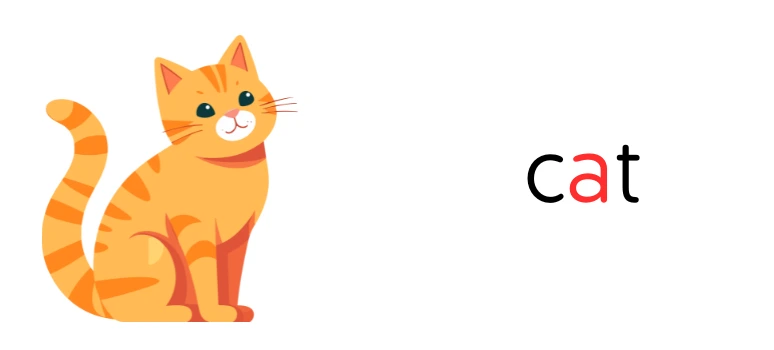
- cup
Used in a sentence: The cup is full of water.

- dog
Used in a sentence: The dog runs in the park.

- hat
Used in a sentence: I wear a hat when it’s sunny.
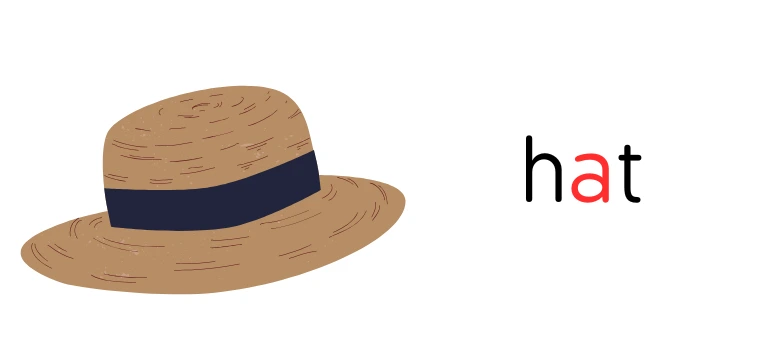
- man
Used in a sentence: The man sat on the bus.

- pen
Used in a sentence: I write my name with a black pen.
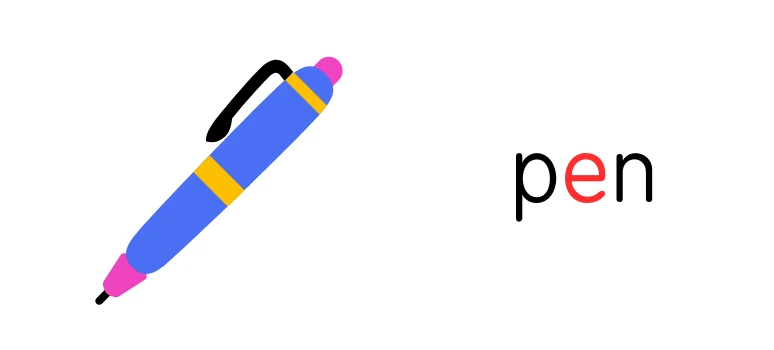
- pig
Used in a sentence: The pig is rolling in the mud.
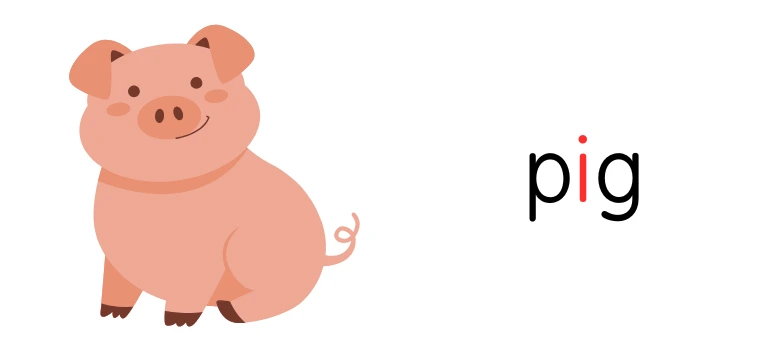
- sun
Used in a sentence: The sun is bright in the sky.

Now, let’s take a look at some short vowel consonant-vowel-consonant words. Below are CVC word lists for vowels A, E, I, O, and U.
Short A CVC Words List
The following words follow the consonant vowel consonant (CVC) pattern and contain the short ‘a’ sound (ă).
We’ve also included an example sentence for each word so your child can see/hear the term used in context.
- bag – I packed my lunch in a bag.
- bat – A bat sleeps during the day and flies at night.
- cab – We took a yellow cab to the hotel.
- can – She can jump very high on the trampoline.
- cap – He put on his baseball cap before going outside.
- cat – The black cat sat on the windowsill.
- dad – My dad reads me a Booka bedtime story every night.
- gap – There is a gap between the fence and the tree.
- ham – He made a sandwich with ham and cheese.
- hat – Her red hat blew away in the wind.
- jam – I spread strawberry jam and peanut butter on my toast.
- lap – The cat curled up on Nonna’s lap.
- man – The man carried a box up the stairs.
- map – We used a map to find the treasure.
- nap – The baby took a short nap after lunch.
- pan – She fried eggs in a hot pan.
- pat – She gave the dog a gentle pat on the head.
- rag – He cleaned the table with a damp rag.
- ram – A ram has strong horns.
- ran – The boy ran to catch the bus.
- rat – A little rat scurried under the table.
- sad – She felt sad when the rain canceled the picnic.
- sap – The tree dripped sticky sap onto the ground.
- sat – He sat on the bench and watched the birds.
- tag – We played a fun game of tag at lunch.
- tap – She turned on the water tap to fill her glass.
- wag – The dog wags its tail when it’s happy.
- yam – Nana cooked a sweet yam for dinner.
Short E CVC Words
The words in the following list follow the CVC pattern and contain the short ‘e’ sound (ĕ). We’ve also included an example sentence for each word.
- bed – I made my bed before going to school.
- beg – The dog will beg for a treat at the table.
- den – The fox sleeps in its den at night.
- fed – She fed the ducks at the pond.
- gem – The shiny gem sparkled in the sunlight.
- get – Can you get me a glass of water, please?
- hen – The hen laid three eggs this morning.
- leg – She hurt her leg while playing soccer.
- let – Mom let me stay up late to read my book.
- met – I met my best friend at the park.
- net – We caught a butterfly with a net.
- pen – I wrote my name with a blue pen.
- pet – My pet rabbit loves to eat carrots.
- red – She wore a bright red dress to the party.
- set – Dad set the table for dinner.
- ten – I counted to ten before opening my eyes.
- vet – The vet took care of the sick puppy.
- wet – My shoes got wet in the rain.
Short I CVC Words List
The following words follow the consonant vowel consonant pattern and contain the short ‘i’ sound (ĭ).
- bib – The baby wore a bib while eating.
- big – The elephant is big and strong.
- bin – She threw the trash in the bin.
- bit – I took just a little bit of cake.
- dip – He likes to dip his fries in ketchup.
- fig – A fig is a small fruit that grows on a tree.
- fin – The fish has a shiny fin.
- fit – The shoes fit perfectly on my feet.
- gig – The band played a gig at the park.
- hid – He hid behind the couch during hide-and-seek.
- him – I gave him a new book to read.
- hit – She hit the baseball out of the park.
- kit – The doctor carries a first-aid kit.
- lid – Put the lid on the jar to keep it fresh.
- lip – She put lip balm on her dry lips.
- lit – He lit a candle in the dark room.
- mix – We mix the flour and sugar to bake a cake.
- pig – The pig rolled in the mud.
- pin – She used a pin to fix her dress.
- pit – The cherry has a small pit inside.
- rib – He ate a rib at the barbecue.
- rid – We need to get rid of old clothes.
- rim – The glass has a gold rim around the top.
- sip – She took a sip of her juice.
- sit – Please sit in your chair and listen.
- tip – He gave the waiter a good tip.
- tin – The cookies are in the tin box.
- wig – She wore a curly wig for the play.
- win – I hope we win the game today.
- zip – Please zip up your jacket before going outside.
Short O CVC Words
Below is a list of short ‘o’ CVC words (i.e., three-letter words that follow the consonant vowel consonant pattern and have a short ‘o’ sound (ŏ)), complete with example sentences.
- bog – The frog jumped into the bog.
- box – She put her toys in a big box.
- cob – We ate corn on the cob for dinner.
- cod – The fisherman caught a cod fish.
- cop – The cop directed traffic at the intersection.
- cot – We set up a cot in the tent.
- dog – The dog barked at the mail carrier.
- fox – A fox ran through the snowy field.
- hog – The hog rolled around in the muddy pen.
- hot – Be careful! The soup is very hot.
- job – Papá has a new job at the office.
- jog – We went for a jog in the park this morning.
- mob – A mob of people gathered in the square.
- mop – He used a mop to clean the floor.
- nod – He gave a nod to show he understood.
- not – That is not the right answer.
- pod – The peas are inside the green pod.
- pop – I heard a loud pop when the balloon burst.
- pot – She cooked soup in a big pot.
- rod – He caught a fish with his fishing rod.
- rob – I saw a raccoon try to rob the bird feeder.
- rot – The apple began to rot after a few days.
- sob – He began to sob when he lost his toy.
- tot – The little tot played with building blocks.
Short U CVC Words List
Below is a list of short ‘u’ CVC words, each with an example sentence to show the word in context.
- bug – A tiny bug landed on my arm.
- bus – We rode the bus to school this morning.
- but – I wanted to play, but it started to rain.
- cup – I drank milk from a small cup.
- cut – Be careful not to cut your finger with the scissors.
- dug – We dug a big hole in the sand at the beach.
- fun – Playing outside with friends is fun.
- hut – The fisherman built a hut near the river.
- hum – She likes to hum her favorite song.
- jug – We poured lemonade from a large jug.
- mud – The pig rolled around in the mud.
- mug – Mum drinks coffee from her favorite mug.
- nut – A squirrel buried a nut under the tree.
- pun – He laughed at the funny pun in the joke book.
- pup – The pup wagged its tail.
- rug – There is a soft rug in the living room.
- run – Kids love to run in the park.
- sum – The math sum was easy to solve.
- sun – The sun is bright in the sky.
- tub – She filled the tub with warm water for a bath.
- tug – He gave the rope a firm tug.
Letter Y CVC Words
While the letter Y is sometimes used as a vowel in words like “cry” and “fly,” it can also appear in consonant vowel consonant words, where it acts as a consonant. Y CVC words are great for phonics practice as they help kids recognize the /y/ sound at the beginning of words.
Below is a list of CVC words with Y and example sentences to provide context.
- yam – I ate mashed yam for dinner.
- yap – The puppy likes to yap when it’s excited.
- yak – A yak is a big, furry animal that lives in the mountains.
- yen – In Japan, people use the yen to buy things.
- yes – She said yes to the invitation.
yum – The cake was so delicious—yum!
V CVC Words
The letter V is less common in consonant vowel consonant words, but a few terms still follow this pattern. Learning V CVC words can help children expand their vocabulary!
Below is a list of CVC words with V and example sentences to provide context.
- van – The blue van is parked on the street.
- vat – The workers filled a large vat with water.
- vet – The vet takes care of sick animals.
K CVC Words List
The letter K appears in a few consonant vowel consonant words, making it an important sound for early phonics practice. These words help children recognize the hard /k/ sound at the beginning or end of words, improving their ability to blend and decode simple terms.
Below is a list of CVC words with K, along with example sentences.
- kid – The kid played outside with his friends.
- kin – She enjoys spending time with her kin during the holidays.
- kit – She packed a first-aid kit for the trip.
- kip – The cat took a quick kip on the couch (British English for "nap").
CVC Words for Preschool (Ages 3 to 5)
For young children in preschool who are just starting to recognize letters and sounds, CVC words are a perfect introduction to reading.
Below is a carefully selected list of CVC words suitable for ages 3 to 5. These simple, three-letter words help preschoolers—or children in nursery school, early childhood education, pre-primary education, reception/Year R, Prescolar, Junior KG, or KG1—learn how to blend sounds, recognize patterns, and build confidence in their early literacy skills.
- bat – A bat sleeps upside down.
- cat – The cat is napping on the rug.
- dog – The dog likes to play fetch.
- hat – She wears a red hat in the sun.
- man – The man has a big smile.
- pan – My abuelo cooks eggs in a pan.
- top – He spins the top on the floor.
- sun – The sun is bright today.
- bug – A little bug crawls on the leaf.
- pig – The pig rolls in the mud.
- jam – I like jelly on my toast.
Kindergarten CVC Words List (Ages 5 to 6)
Children in kindergarten—also referred to as Year 1, Senior KG, KG2, kínder, prep, Prescolar, etc.—begin to strengthen their phonics skills and blend sounds to read simple words. Consonant vowel consonant words are a key part of this stage, helping young learners develop confidence in decoding, spelling, and recognizing word patterns.
Below is a carefully selected list of CVC words for kindergarten kids, along with example sentences.
- bag – She carries her school books in a bag.
- can – I can jump really high!
- cap – He wears a blue cap to the park.
- dad – My dad makes the best pancakes.
- fan – The fan keeps the room cool in summer.
- fox – A fox has a big, bushy tail.
- gum – She chewed a piece of bubble gum.
- ham – We had ham and eggs for breakfast.
- jet – The jet flies high in the sky.
- log – We sat on a log near the campfire.
- mop – He used a mop to clean the floor.
- net – We caught a fish with a net.
- pet – My pet dog loves to play fetch.
- pin – He stuck a pin on the map.
- rat – A rat ran across the kitchen floor!
- red – She wore a bright red dress.
- run – We love to run around the playground.
- sit – Please sit next to me.
CVC Words List for 1st Grade (Ages 6 to 7)
Kids in Grade 1—also referred to as Year 2, Class I, or 1º Primaria—begin to read more fluently, expand their vocabulary, and improve their spelling skills. At this stage, CVC words help reinforce phonics rules, build reading confidence, and serve as a stepping stone to more complex words.
Below is a CVC words list for 1st grade, complete with example sentences.
- bet – I bet you will love this game!
- bun – He ate a warm bun with butter.
- cub – The lion cub played with its mother.
- dig – We dig holes in the sand at the beach.
- dot – She put a red dot on the paper.
- fog – Thick fog covered the hills this morning.
- hop – The bunny likes to hop in the garden.
- mad – Our teacher was mad when we made a mess.
- pot – He cooked soup in a big pot.
- rag – I found an old rag in the shed.
- ran – The dog ran across the yard.
- van – Our van is white.
CVC Words for 2nd Grade (Ages 7 to 8)
Children in Grade 2—also referred to as Year 3, Class II, 2º Primaria, etc.—are becoming more confident readers. They start transitioning from basic phonics to more advanced reading skills, including longer words, blends, and sight words. However, CVC words still play a vital role in reinforcing spelling patterns, fluency, and foundational literacy skills.
Below is a CVC words list for 2nd graders.
- cab – We took a cab to the museum.
- fad – Wearing neon clothes was a fun fad in the 80s.
- gap – There is a small gap between the books.
- jab – He gave the dough a gentle jab with his finger.
- jog – We went for a short jog in the park.
- kid – The kid played soccer with his friends.
- kit – She got a coloring kit for her birthday.
- mug – She likes to drink hot cocoa from a mug.
- nag – My little brother likes to nag me about playing games.
- pat – Mom gave me a pat on the back.
- peg – He hung his coat on the peg.
- rob – The villain tried to rob the bank in the movie.
- rod – He caught a big fish with his fishing rod.
- rug – She put a new rug in her room.
- tag – He put a name tag on his knapsack.
CVC Words for 3rd Grade (Ages 8 to 9)
In Grade 3—also referred to as Year 4, Class 3, 3o Primaria, middle primary school, etc.—most kids are reading more fluently and expanding their vocabulary. While they are learning longer words, contractions, and compound words, CVC words still play an essential role in reinforcing spelling patterns, decoding skills, and fluency.
At this stage, children can benefit from using consonant vowel consonant words in writing, word games, and creative reading activities.
Below is a CVC words list for 3rd graders.
- beg – I beg Mama to read me another story.
- bog – The frog jumped into the bog near the lake.
- dip – She likes to dip her cookies in milk.
- hut – The travelers stayed in a wooden hut in the forest.
- lit – She lit a candle during the power outage.
- pod – The peas were still inside the pod.
- sum – The sum of two and three is five.
- tug – She had to tug the door to open it.
- vet – We took our dog to the vet for a check-up.
- wit – His quick wit made everyone laugh.
Nonsense CVC Words
As children learn CVC words, they start recognizing common word patterns. However, they may also begin memorizing words rather than truly decoding them. This is where nonsense CVC words (also called pseudo-words) become valuable.
Nonsense CVC words are made-up words that follow the consonant-vowel-consonant pattern but don’t have meaning. For example, bip, zot, and fep. Teaching nonsense consonant vowel consonant words helps children strengthen their phonics skills by ensuring they can sound out words rather than relying on memorization. (PSST! Be sure to check out these phonics activities for more ideas for teaching phonics at home.)
Here are some more examples of nonsense CVC words:
- bip
- zun
- jeb
- rof
- vam
Now, let’s discuss how you can start teaching CVC words at home!
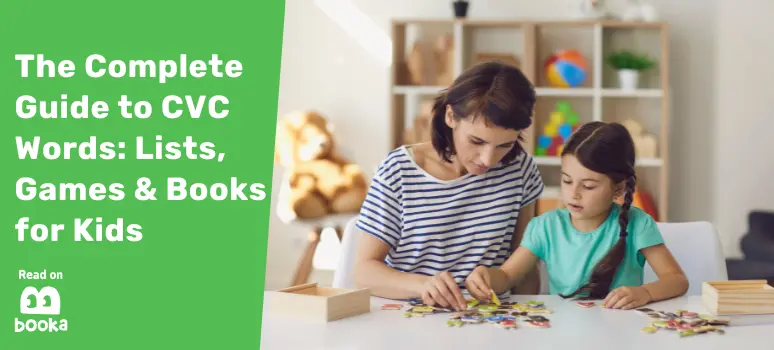
How to Teach CVC Words Step-By-Step
Teaching CVC words is an essential step in helping children learn to read. These simple three-letter words allow kids to practice blending sounds, recognizing patterns, and building confidence in their reading skills.
Following the steps below, parents and caregivers can help children master CVC words and develop strong reading skills.
PRO TIP: The key is to make learning interactive, engaging, and stress-free, so we highly recommend using fun kids’ books, games, and activities (check out our suggestions below).
Teach Letter Sounds First
Before introducing CVC words, ensure your child knows the sounds of individual letters (not just their names). They should be able to recognize and say the sounds of consonants and vowels (short vowels, at least).
How to do this:
- Use flashcards with letters and their sounds.
- Sing alphabet phonics songs to reinforce letter-sound associations.
- Play letter-matching games to help with recognition.
Introduce Sound Blending
Once your child knows letter sounds, teach them to blend sounds to form words. This means putting together individual sounds to read a word.
How to do this:
- Say the individual sounds in a word out loud (e.g., c-a-t), pointing to each letter as you say its sound. Then, blend the sounds together to form the word (e.g., cat).
- Have your child repeat after you until they can do it independently.
TIP: Use magnetic letters or letter tiles to represent each sound, then physically move the titles (i.e., sounds) together to show the sounds combining visually.
Practice CVC Words Individually
Once your child understands sound blending, introduce one CVC word at a time to help them focus on reading whole words.
How to do this:
- Write a single CVC word on a whiteboard or flashcard and say the sounds slowly (e.g., m-u-g).
- Have your child repeat the sounds and then say the word as a whole (e.g., mug).
- Use pictures or objects to help them connect the word to its meaning (e.g., show a picture of a cat while reading "cat").
- Repeat this process with new words, gradually increasing difficulty as their confidence grows.
This method helps reinforce word recognition, improve blending skills, and prevent overwhelming young readers.
Use Word Families to Show Patterns
Once your child can blend sounds and read some individual CVC words, introduce word families to help them recognize common spelling patterns.
In early phonics instruction, word families refer to groups of words with the same spelling and sound pattern. The words in a word family also often rhyme (e.g., "cat," "bat," "hat"). More broadly, the term “word family” can also refer to words that share a common root word with different suffixes or prefixes (e.g., help, helpful, helpless). However, for early readers, the focus is on phonics-based word families.
Recognizing word families helps kids identify spelling patterns, making it easier for them to read and decode unfamiliar words.
Examples of word families:
- "-at" family: cat, bat, hat, mat, rat
- "-et" family: bet, get, jet, let, pet
- "-ig" family: big, dig, fig, pig, wig
- "-op" family: cop, hop, mop, pop, top
- "-un" family: bun, fun, pun, run, sun
How to do this:
- Start with a base word (e.g., big) and change the first letter to create new words (dig, fig, pig).
- Play rhyming games by saying a word ("pan") and asking your child to think of a rhyming word ("man").
- Create a word family chart and add new words as your child learns them.
- Read books that focus on word families to strengthen pattern recognition.
Practice Reading CVC Words Fluently
Once your child can sound out and recognize CVC words, the next step is to help them read words smoothly without pausing to decode each letter.
How to do this:
- Have your child read short CVC word lists aloud, focusing on reading smoothly rather than one letter at a time.
- Introduce simple CVC sentences (e.g., The cat sat on a mat.) to practice reading words in context.
- Read CVC word books together, encouraging your child to read familiar words fluently while you help with harder ones. Check out our recommended children’s books below.
Tips for Teaching CVC Words at Home
- Encourage daily practice. Consistent practice is key to learning CVC words. Short daily reading sessions (recommendation: 10–15 minutes/day) will help your child improve steadily.
- Be patient and encouraging. If your child struggles, help them sound out the word instead of correcting them immediately.
- Celebrate progress by praising their effort and improvement.
- Read CVC books together. Reading simple CVC books helps children see words in real sentences and builds their confidence.
- Make learning fun with games and activities. Children learn best through engaging activities that make reading enjoyable! Check out some fun CVC word games below!
CVC Word Games
Learning consonant vowel consonant words doesn’t just have to be worksheets and flashcards! Interactive games can help children practice blending sounds, recognizing patterns, and building reading confidence in an engaging way.
Below are a few simple, fun CVC word games that parents and caregivers can use at home.
CVC Word Bingo
This classic game helps kids recognize and read consonant vowel consonant words.
What You’ll Need to Play:
- A homemade bingo board with CVC words instead of numbers
- Small objects (buttons, coins, or stickers) to mark words
- A list of consonant vowel consonant words to call out (feel free to use our CVC word lists above!)
How to Play:
- Give each player a bingo board with different CVC words.
- Call out a CVC word. If your child finds it on their card, they should cover it with a button, sticker, coin, or other small object.
- The first player to complete a row or column shouts "Bingo!" and wins the game.
How This CVC Word Game Helps:
- Reinforces word recognition and reading fluency
- Helps kids quickly identify and decode CVC words
- Can be played independently or in groups
Consonant Vowel Consonant Hopscotch
This movement-based game turns CVC word learning into active play!
What You Need:
- Sidewalk chalk (for outdoor play) or masking tape (for indoor play)
- A list of CVC words
How to Play:
- Draw/mark a hopscotch grid with CVC words inside each box.
- Call out a word. Your child must hop to the correct word while saying it aloud.
- Encourage your child to blend the sounds together as they hop (e.g., c-a-t, cat!).
How This CVC Game Helps:
- Strengthens word blending and sound recognition
- Engages learning through movement (plus, it’s great exercise!)
- Turns learning into a fun, active experience
CVC Word Mystery Bag
This simple sensory game helps children connect words to real-world objects.
What You’ll Need to Play:
- A bag filled with small items that match CVC words (e.g., cat toy, pen, cup)
- Consonant vowel consonant word flashcards
How to Play:
- Have your child pull an object from the bag without looking.
- Ask them to say the object's name aloud and match it to the correct CVC word card.
- Have them sound out the word before placing the object next to the card.
How This Game Helps:
- Reinforces word-meaning connections
- Helps children sound out and recognize consonant vowel consonant words in real life
- Encourages multi-sensory learning through touch and sight
Looking for a simple, fun, and low-stress way to teach CVC words at home? Reading phonics books with consonant vowel consonant words is an excellent way to introduce your child to these terms!
CVC Word Books
One of the best ways to help children practice CVC words is through phonics-based books that feature simple, repetitive text. These books reinforce sound blending and word recognition and help build reading confidence in a fun and engaging way.
Here are some of our favorite phonics stories with consonant vowel consonant words.
No Naps for Pals
Written By Kim Thompson
Illustrated By Brett Curzon
No Naps For Pals is a decodable reader focused on the short ‘a’ sound. The book includes numerous short ‘a’ CVC, high-frequency, and VC (vowel consonant) words.
Some of the short ‘a’ consonant vowel consonant words used in the story include “rag,” “cap,” “gas,” “lap,” “nap,” “pat,” “rat,” “sat,” and “tag.”
As an added bonus, No Naps For Pals includes a grid at the beginning of the story that shows the CVC words introduced in the book, along with pictures that depict their meaning. This is a great learning tool, as it will help your child connect meaning to each word, enhancing comprehension, recognition, and recall!
Ed and Em
Written By Kim Thompson
Illustrated By Brett Curzon
Ed and Em is a decodable book that includes CVC words that focus on the short ‘e’ sound. For example, “den,” “red,” “men,” “pen,” “set,” “ten,” “wet,” and “yes.”
Ed and Em also includes a table at the beginning of the story that shows all the new words introduced in the book, along with pictures that portray their meaning.
Fix This!
Written By Kim Thompson
Illustrated By Brett Curzon
Fix This! is a decodable reader that includes lots of CVC words that focus on the short ‘i’ vowel sound (e.g., “six,” “sit,” “fix”). The story also includes examples of short ‘i’ in VC and high frequency words.
Similar to No Naps for Pals and Ed and Em, this CVC word book includes a grid at the beginning of the story that shows all the new words with pictures that depict their meaning—to help enhance learning, memory, and vocabulary development.
Tib’s Big Rig
Written By Kim Thompson
Illustrated By Brett Curzon
Tib’s Big Rig is another CVC word book focusing on the short ‘i’ vowel sound. Like Fix This!, this story includes VC, CVC, and high frequency words that contain the short ‘i’ sound. The book also includes a table at the beginning that shows new words and pictures that represent their meaning.
Some examples of the CVC words found in this book include “big,” “dip,” “sit,” “pit,” “rip,” “sip,” “tip,” and “zig.”
BONUS: Tib’s Big Rig is available as a read along book on the Booka reading app for kids!
Doc’s Job
Written By Kim Thompson
Illustrated By Brett Curzon
Doc’s Job is a decodable reader focused on the short ‘o’ sound. Like Fix This! and Tib’s Big Rig, this story uses the short vowel sound frequently in CVC, VC, and high frequency words. The book also includes a table at the beginning that shows these words with pictures representing their meaning.
Examples of the CVC words with short ‘o’ found in this story include “cob,” “cot,” “doc,” “jog,” “hog,” “job,” “sob,” and “hot.”
BONUS: Doc’s Job is also available as a read aloud story on the Booka reading app for kids!
Fun For Pups
Written By Kim Thompson
Illustrated By Brett Curzon
Fun For Pups is a decodable story with CVC words that focus on the short ‘u’ vowel sound. The story uses the short ‘u’ sound in VC (vowel consonant), CVC (consonant vowel consonant), and high frequency words.
Examples of the consonant vowel consonant words with short ‘u’ found in this book include “tug,” “hug,” “mum,” “pup,” “bus,” and “tub.”
Fun For Pups also includes a “Sounds and Letters” table at the beginning that demonstrates all the new words in the book, along with pictures.
Looking for more CVC word books for your child to read at home? Try the Booka reading app!
Teach CVC Words with Booka
The more your child practices reading CVC words, the stronger their phonics, blending, and decoding skills will become. With Booka’s expansive digital library, kids can explore fun, engaging phonics-based books designed to make CVC word practice easy and enjoyable.
Download the Booka app today and discover colorful, interactive CVC word books that will boost your child’s early literacy skills and make learning to read exciting!
